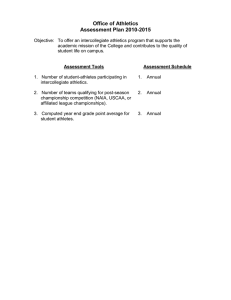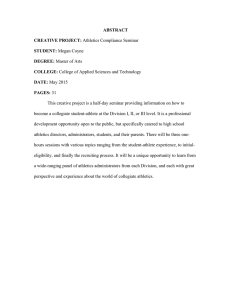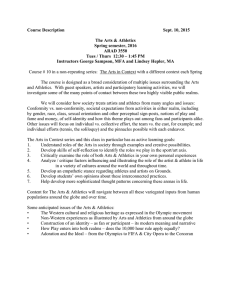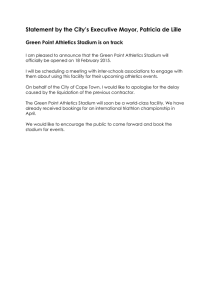Senate Budget Committee Spring 2014 Report
advertisement
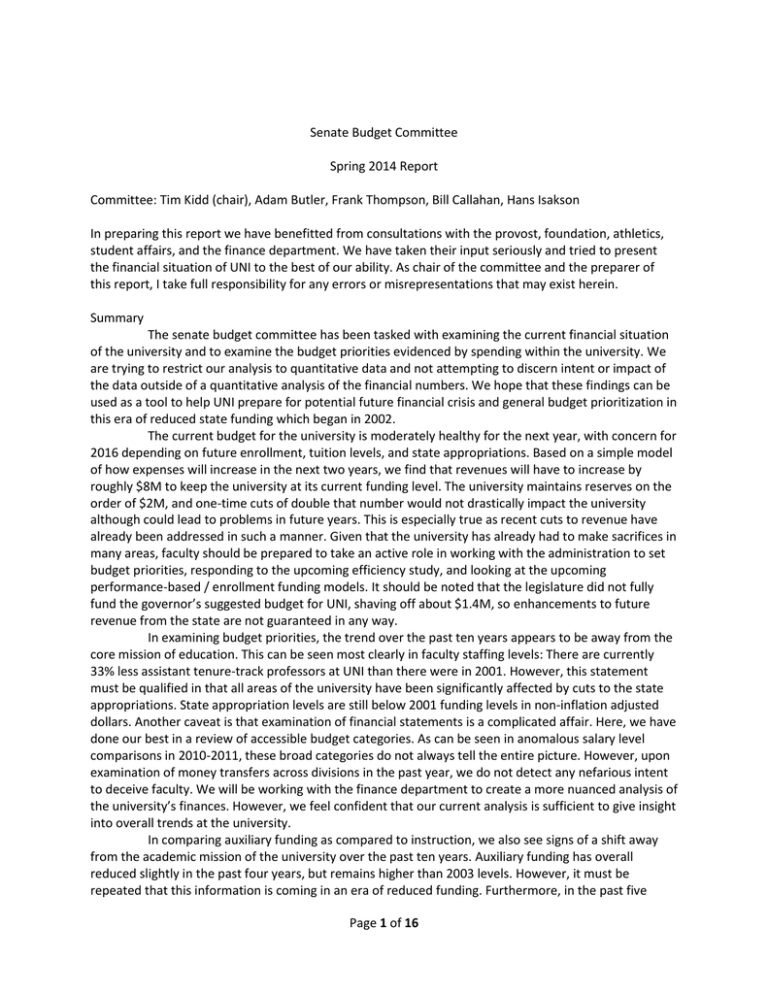
Senate Budget Committee Spring 2014 Report Committee: Tim Kidd (chair), Adam Butler, Frank Thompson, Bill Callahan, Hans Isakson In preparing this report we have benefitted from consultations with the provost, foundation, athletics, student affairs, and the finance department. We have taken their input seriously and tried to present the financial situation of UNI to the best of our ability. As chair of the committee and the preparer of this report, I take full responsibility for any errors or misrepresentations that may exist herein. Summary The senate budget committee has been tasked with examining the current financial situation of the university and to examine the budget priorities evidenced by spending within the university. We are trying to restrict our analysis to quantitative data and not attempting to discern intent or impact of the data outside of a quantitative analysis of the financial numbers. We hope that these findings can be used as a tool to help UNI prepare for potential future financial crisis and general budget prioritization in this era of reduced state funding which began in 2002. The current budget for the university is moderately healthy for the next year, with concern for 2016 depending on future enrollment, tuition levels, and state appropriations. Based on a simple model of how expenses will increase in the next two years, we find that revenues will have to increase by roughly $8M to keep the university at its current funding level. The university maintains reserves on the order of $2M, and one-time cuts of double that number would not drastically impact the university although could lead to problems in future years. This is especially true as recent cuts to revenue have already been addressed in such a manner. Given that the university has already had to make sacrifices in many areas, faculty should be prepared to take an active role in working with the administration to set budget priorities, responding to the upcoming efficiency study, and looking at the upcoming performance-based / enrollment funding models. It should be noted that the legislature did not fully fund the governor’s suggested budget for UNI, shaving off about $1.4M, so enhancements to future revenue from the state are not guaranteed in any way. In examining budget priorities, the trend over the past ten years appears to be away from the core mission of education. This can be seen most clearly in faculty staffing levels: There are currently 33% less assistant tenure-track professors at UNI than there were in 2001. However, this statement must be qualified in that all areas of the university have been significantly affected by cuts to the state appropriations. State appropriation levels are still below 2001 funding levels in non-inflation adjusted dollars. Another caveat is that examination of financial statements is a complicated affair. Here, we have done our best in a review of accessible budget categories. As can be seen in anomalous salary level comparisons in 2010-2011, these broad categories do not always tell the entire picture. However, upon examination of money transfers across divisions in the past year, we do not detect any nefarious intent to deceive faculty. We will be working with the finance department to create a more nuanced analysis of the university’s finances. However, we feel confident that our current analysis is sufficient to give insight into overall trends at the university. In comparing auxiliary funding as compared to instruction, we also see signs of a shift away from the academic mission of the university over the past ten years. Auxiliary funding has overall reduced slightly in the past four years, but remains higher than 2003 levels. However, it must be repeated that this information is coming in an era of reduced funding. Furthermore, in the past five Page 1 of 16 years, auxiliary units have been charged overhead costs and at least a portion of utilities and other maintenance costs which do not appear in the budget for academic departments. There also appears to be a shift toward administrative and support funding at the expense of instruction over the past ten years. There are challenges in performing such an analysis and we are doing our best to analyze a complex situation with available information. While we believe our results are correct, we will be working with the finance department to more closely examine these trends and report back in the fall with further analysis. The financials of the athletics department stand out in our analysis of auxiliaries. First – the athletics department has done a commendable job of increasing revenues – about 150% over the past ten years. They have also done a great job in working with the foundation – using donations directed towards athletics at the intent of donors – to generate external revenue. Having said this, expenses and salaries have also increased significantly in the athletics department, and there is a current liability of over $700k. While this is mostly due to unpaid vacation, eventually this bill will come due. General fund support for athletics has decreased in the last few years, but still exceeds 2001 levels by 7%. In an era in which fewer resources are being devoted to hiring new assistant professors and S&S budgets have stagnated, it would seem that the university could further reduce general fund support for auxiliary units to shore up academic programs. Still, other areas of the university might consider examining the activities of the athletics department to learn more about generating external revenue. We have also investigated the impact program cuts have had on the university in recent years. For example, in looking back on the MPLS closure we found that the actual financial impact on the university was not necessarily significant cost savings but instead appears to result in a reallocation of resources within the college of education. The closure induced one-time expenses of $2.5M and an annual cost savings of about $200k. However, there were also significant expenses not incurred by the university from avoiding deferred maintenance that could be estimated in the millions of dollars. One should also consider the impact of this closure (and the associated program cuts of that year) on the reduction in enrollment and tuition revenues in the fall of 2012. In total, net tuition and fee revenues in 2011-2012 were $66M and $65M in 2012-2013, with the reduction in revenue from smaller incoming classes impacting current and at least near future revenues. It is impossible to know exactly what direct impact closing MPLS had on tuition revenues but there would seem to be some correlation. In comparing two major cuts made to cut costs in response to budget cuts at UNI in the past ten years – baseball in 2009 and the MPLS/academic program closures in 2012 – there were very different outcomes for the university. While ending baseball had no detectable impact on enrollment, enrollments dropped significantly after the academic closures. In addition to baseball not being an academic program, the decision to end baseball was made after analysis as a reallocation of resources by its stakeholders, the athletics department. The academic closures were made quickly, in comparison, and did not significantly involve the stakeholders (faculty). These events show that care must be taken in undertaking cost-cutting measures in order to fully ascertain their effects on the university as a whole. Page 2 of 16 I. Future outlook: Given the current UNI budget passed by the state legislature, UNI should be in moderate financial health for FY15 (AY 14-15). The university should have a net balance of ~$900k including its tuition contingency fund with current enrollment estimates. However, significant problems could occur as easily as FY 16 depending on state appropriations. Given current trends, expenses will increase by $4M and the one-time $4M state appropriation will end. Projected tuition revenue is conservative, with no net increase in our simple model. However, given relatively small recent incoming classes, tuition revenues can be expected to hold at current levels even with improved enrollment for the near future. In order for the university to operate in its existing state for FY16 2 years from now, there will need to be an increase in revenue of about $8M between state appropriations, increased enrollment, and tuition increases from the current proposed budget of FY15 (next year). Given current enrollment trends, it is expected that the bulk of this revenue will need to come from state appropriations. For comparison, state appropriations increased by $6M for FY15. The administration seems to appreciate this situation and appears to be working to address the funding situation. The picture should become clearer by next fall given the course of the efficiency study and potential changes to how state appropriations are divided between the three regent’s universities. To understand the level of cuts to the state appropriations, it is useful to compare to 2001, the year before major cuts began. The FY15 state appropriations is set at $89M. In 2001, it was $96.8M. Adjusted for inflation, the 2001 state appropriations would be $129M, an effective 44% reduction in state appropriations since 2001. II. Financial reserves In general the university does not have money slated for “reserves” outside of the enrollment contingency fund, which is reserved for cases in which enrollment does not meet expectations. It is important to note that the designation “unrestricted” is an accounting term which does not mean funds can be used for any purpose. The university typically uses a mixture of salary savings (putting off new hires), initiative funds of the president and provost, and other sources. The foundation has very limited “unrestricted” assets that could be used for financial emergencies, the Vision Fund. The Vision Fund currently has assets of $2M of which earnings of roughly $85k could be used for emergencies. For FY15 (next year) the expected reserves of the university are roughly $1.8M, although it would be expected that we could survive a shortfall of approximately double that without immediate need for dramatic cuts. In addition, each division, including academic affairs, can roll over up to 1% of its total budget for the next year which nominally creates a financial cushion for academic and other programs. III. Faculty numbers We have analyzed the priorities of the university based on the number of instructors defined as tenured, tenure-track, full time non-tenure track, and part time non-tenure track since 2001. The number of tenured positions has held steady, but tenure-track positions have declined significantly starting in 2004, coinciding with cuts in state appropriations. At the same time, part time non-tenure Page 3 of 16 track positions have risen. The numbers indicate that the university is moving away from hiring assistant professors and towards adjuncts in response to budget cuts. IV. Expenses based on type and salary budgeting priorities Except for 2011, there has been a steady increase in salaries for institutional support (administration) and academic support at the expense of instruction. This year appears to be anomalous as there were no associated increases in the number of full time or part time (tenured, tenure-track, or adjunct) at this time. This information bears further review as it could arise from one-time events (furloughs, early retirement incentives, etc…) or possibly reclassification of job titles rather than a real increase in support for instruction. In addition, salaries in auxiliary units, especially athletics, have risen significantly more than salaries devoted to instruction. After examining these anomalies, a more refined analysis is needed and we will be working with the finance division in the coming months to achieve a clearer picture of these trends. V. Auxiliaries Over the past four years, support for auxiliaries from the GEF has fallen by about 7%. However, certain areas stand out, particularly athletics. While GEF support for athletics has declined over the past four years, when we look at ten year trends, the picture is more complicated. First – the athletics department has done an exemplary job of increasing revenue. The foundation has also helped increase revenues greatly (400%) over the past ten years. However, this increase in revenue has not been offset by a significant decrease in GEF support, which over ten years has risen by 7%. Also, the athletics department has a net liability which now exceeds $700k. VI. Special Report on Malcom Price Lab closure The closure of MPLS and renovation of the child daycare center (CDC) resulted in one-time expenses exceeding $2.5M including renovations in the final year of over $300k. Annual savings were reported to be approximately $667k, however this does not include $2M in additional revenue from the state legislature which began the year before the school was closed. Analysis of the true impact of the closure is difficult, as one must consider the impact on enrollment and deferred maintenance costs. The overall outcome appears to be a reallocation of resources to other academic areas within the college of education with net savings of about $200k not taking into account deferred maintenance costs or impact on enrollment. VII. Impact of closures: Baseball 2009, MPLS/Academic Programs 2012 We examined the impact that cutting baseball had on enrollment and donations to the UNI foundation. We found no significant impact on ending the baseball program. However, individual year variations in donations can be very significant, so there could have been an impact on donations which was washed out by single year events. We also examined the impact of closing MPLS and many academic programs in 2012. Again, there was no significant impact on donations, which can be strongly impacted by single year events (i.e. a single large donation, economy, etc…). However, the impact on enrollment was very significant and negative. While there are other factors that influence enrollments such as Iowa demographics and increased competition from other regent’s universities, it is very unlikely that Page 4 of 16 the drop in enrollment immediately following the closure of MPLS and many academic programs is coincidental. The impact from the two different events was very different. Besides being a non-academic program, the decision to cut baseball was a calculated decision by the athletics department to reallocate resources in response to overall budget cuts for the university. In contrast, the decision to cut academic programs and MPLS, while also induced by budget cuts, seemed to be made very quickly and did not involve the primary stakeholders (faculty) and so seemingly would not have taken into account all of the possible outcomes such cuts could have on the university as a whole. Examination of the outcomes of both events shows that cuts should be made in a careful manner to mitigate negative effects on the university. Page 5 of 16 Report I. Current and Near Future Budgets FY14 Budget Change 14-15 FY15 Budget Change 15-16 Estimate for 2016 $83,222,819.00 $5,953,913.00 $89,176,732.00 $0.00 $89,176,732.00 $6,000,000.00 ($2,000,000.00) $4,000,000.00 $0.00 $0.00 $821,000.00 $0.00 $821,000.00 $0.00 $821,000.00 tuition UR $57,550,029.00 $0.00 $57,550,029.00 $0.00 $57,550,029.00 tuition UNR $12,333,414.00 $308,335.00 $12,641,749.00 $0.00 $12,641,749.00 $5,414,771.00 $108,295.00 $5,523,066.00 $0.00 $5,523,066.00 $763,422.00 $19,086.00 $782,508.00 $0.00 $782,508.00 $0.00 $392,232.00 $392,232.00 $0.00 $392,232.00 $76,061,636.00 $827,948.00 $76,889,584.00 $0.00 $76,889,584.00 $1,316,649.00 $0.00 $1,316,649.00 $0.00 $1,316,649.00 $483,393.00 $0.00 $483,393.00 $0.00 $483,393.00 $167,905,497.00 $4,781,861.00 $172,687,358.00 $0.00 $168,687,358.00 $133,836,989.00 $3,296,802.00 $137,133,791.00 $3,296,802.00 $140,430,593.00 $12,589,462.00 $0.00 $12,589,462.00 $0.00 $12,589,462.00 $13,692,016.00 $9,149.00 $13,701,165.00 $9,149.00 $13,710,314.00 $8,041,397.00 $313,604.00 $8,355,001.00 $313,604.00 $8,668,605.00 $0.00 $1,329,600.00 $1,329,600.00 $0.00 $1,329,600.00 $168,159,864.00 $4,949,155.00 $173,109,019.00 $3,619,555.00 $176,728,574.00 ($254,367.00) ($167,294.00) ($421,661.00) ($167,294.00) ($8,041,216.00) state base state 1 time Interest tuition GR tuition GNR new student Total Tuition Indirect Sales total revenue personnel expenses nonpersonnel expenses financial aid institutional accounts Contingency Fund total expense Net Note: Expenses listed in 2016 increase at the same pace as from 2014 to 2015. This is a conservative estimate to highlight future funding needs. However, significantly larger numbers of incoming students will be needed to maintain current enrollment levels, so significant increases in tuition revenue should Page 6 of 16 not be expected in the near term. If additional one-time money is not secured, revenues from appropriations and tuition revenue will need to be about $8M to keep the university at current levels. The net shortfall for FY15 can be covered by the current contingency fund if enrollment estimates are correct. For comparison, state appropriations in 2001 were $96,780,065. Accounting for inflation, state appropriations would be $129M if funding levels now were consistent with 2001 (http://data.bls.gov/cgi-bin/cpicalc.pl) Page 7 of 16 II. Current Reserves 1. Current Reserves in FY15 budget Enrollment Contingency Fund Inst. Strategic Initiatives Payout (not principle) of Vision Fund $1,329,600.00 $400,000.00 $90,000.00 2. In the event of revenue shortfalls, the following assets are used. These are 1-time measures which generally push financial issues forward to future years - Enrollment Contingency - Prior Year Carry Forward - Salary/Fringe Savings - Lump Sum Amounts Assigned to Each Division - Institutional Strategic Initiatives - Provost Initiatives Fund - Misc Savings from Institutional Expense account (audit, insurance, legal) - Reduction in Financial Aid - Summer Session Salary Savings (if any) - Utilities - ERIP (Early Retirement Incentive Program) - Operational changes, i.e., utilities charges to all auxiliaries; 2.5% Administrative Overhead to all non-General Fund accounts (per policy on Financial Accounting & Reporting website), reduction in support to Auxiliaries Page 8 of 16 III. Faculty Numbers Table of Trends in Instructor / Professor Positions from UNI Fact Book Year by Fall Part Time + full time 2001 2002 200 2004 2005 2006 2007 2008 2009 2010 2011 2012 2013 434 424 437 445 446 456 459 463 467 463 466 453 450 178 177 177 142 144 130 122 131 126 121 127 112 119 full time 106 93 71 74 79 79 78 80 75 79 92 69 61 part time 134 148 114 123 160 145 152 181 142 160 147 154 171 Tenured Tenure Track (asst.) Non TenureTrack Based on current trends, the University is moving away from hiring tenure track professors (beginning in 2004) and towards hiring part time adjuncts. The impact of part time adjuncts is difficult to discern from this headcount in that this does not reflect the number of courses taught. 10.0% 5.0% 0.0% -5.0% -10.0% Part Time Non Tenure-Track -15.0% Tenure Track -20.0% -25.0% -30.0% -35.0% -40.0% The number of tenure-track assistant professors has fallen 33% since 2001. This is part of a national trend not unique to UNI and coincides with cuts in state appropriations beginning in 2002. Page 9 of 16 IV. Expenses based on type and salary budgeting priorities (in k$) 2003 2004 2005 2006 2007 2008 2009 2010 2011 2012 Instruct. $55,079 $57,091 $57,359 $59,422 $60,302 $62,875 $66,492 $60,382 $65,170 $67,096 Academic Support Inst. Support $14,560 $13,711 $13,393 $13,947 $14,005 $15,343 $16,155 $16,253 $12,484 $12,717 $15,941 $16,681 $17,338 $18,473 $19,110 $20,228 $21,938 $22,558 $19,078 $21,228 Note years 2010-2011 are anomalous. There is a sharp drop in academic support & institutional support & increase in instruction. This does not correlate with a sharp increase in faculty #’s. It is not clear whether this is from one-time circumstances as this year coincided with furloughs and an early retirement incentive plan or possibly from re-categorization of job titles in this year. This year merits further investigation to clarify the information and shows the need for more nuanced analysis. Table of Salaries for Selected Groups as Compared to total Salary Expenditures Salaries as % of total salaries Faculty (from instruction category) Institutional support Auxiliary enterprises Athletic salaries Change since 2003 Faculty (from instruction) Institutional support Auxiliary enterprises Athletic salaries 2003 2004 2005 2006 2007 2008 2009 2010 2011 2012 39.43% 39.99% 39.33% 39.85% 39.43% 38.77% 37.82% 36.24% 37.86% 37.79% 11.41% 11.68% 11.89% 12.39% 12.49% 12.47% 12.48% 13.54% 11.08% 11.96% 13.61% 13.87% 14.10% 14.60% 14.87% 14.91% 14.70% 15.16% 15.37% 15.50% 2.17% 2.35% 2.42% 2.40% 2.55% 2.49% 2.65% 2.86% 2.91% 2.88% - 1.42% -0.25% 1.07% 0.00% -1.67% -4.08% -8.09% -3.98% -4.16% - 2.37% 4.21% 8.59% 9.47% 9.29% 9.38% 18.67% -2.89% 4.82% - 1.91% 3.60% 7.27% 9.26% 9.55% 8.01% 11.39% 12.93% 13.89% - 8.29% 11.52% 10.60% 17.51% 14.75% 22.12% 31.80% 34.10% 32.72% The portion of the overall budget devoted to faculty salaries has dropped in the past ten years. Other areas have seen a larger budget priority, especially in auxiliaries, led by an increase in salaries within the athletics department. Not all auxiliary salaries are paid for by the general fund, and athletics in particular generates significant external revenue. Note that the percentage of athletics salaries has increased overall despite dropping the baseball program in 2009. Also the 2011 year drop in institutional support coincided with a relatively large increase in the instruction category. This merits further investigation as mentioned above. Page 10 of 16 % Change in Salary Levels as a percentage of total UNI Salary since 2003 40.00% 35.00% 30.00% 25.00% 20.00% 15.00% 10.00% 5.00% 0.00% 2003 2004 2005 2006 2007 2008 2009 2010 2011 2012 -5.00% -10.00% -15.00% Faculty (from instruction) Institutional support Auxiliary enterprises Athletic salaries Graph represents how the % of total salary dollars has changed since 2003. As a percentage of total salaries at UNI, only instruction has decreased in the past ten years. Athletics salaries (as a percentage of total salaries at UNI) have increased more than 30%. The 2010-11 years have anomalies with regards to instruction and institutional support (administration) as discussed above. This comparison eliminates inflation and other considerations as it is derived from comparison to total UNI salary levels in an attempt to best analyze budgeting priorities of the institution. Page 11 of 16 V. Auxiliaries Table of Expenditures to Auxiliary Units from General Fund 2009-2010 2010-2011 2011-2012 General Educational Fund Revenue 172,120,593.85 161,704,799.10 161,486,788.60 Auxiliary Enterprises GEF Received Residence Athletics 4,449,174.00 4,559,447.00 4,323,026.00 Mauker Union 619,837.00 598,286.00 603,570.00 Field House 750,464.40 750,000.00 750,000.00 GBPAC 851,328.00 848,739.00 812,802.00 WRC 874,692.00 782,274.00 766,716.00 Student Health System 420,411.00 188,213.00 197,469.00 Miscellaneous Total Auxiliary Enterprises – Field 7,215,442.00 6,976,959.00 6,703,583.00 house 2012-2013 167,114,885.32 4,198,513.00 676,292.00 750,000.00 828,011.00 781,150.00 200,554.00 6,684,520.00 % of GEF that go to Aux. Enterprises 4.63 4.31 4.15 4.00 2.58 2.82 2.68 2.51 % of GEF that go to Athletics Athletics has reduced its dependence on the general fund over the past four years. Support for auxiliaries in total are decreasing in this time period, but remain above the 3% threshold from the faculty senate resolution passed in 2009. Given that athletics has been seen as a financial concern in some quarters, we have investigated the financial details of athletics in more detail (see table below). After peaking around 2008 (30% larger than 2003), GEF support for athletics has reduced to be only 7% larger than 2003 levels. The athletics department has also significantly increased its non-GEF revenues over the past 10 years (~ 150%). Foundation derived revenues have also increased by about 400% and NCAA support has doubled. However, both salaries and other expenses have both increased by nearly 70% while GEF support has increased by 7%. Another potential issue is that athletics has a consistent net liability (for 2013 this exceeds $700k). While this net liability is reported to be mainly due to untaken vacation and other leave, this bill will eventually come due. While the athletics department has done an admirable job of generating non-GEF revenue, given that academic funding has stagnated and appropriations have essentially been reduced in this time period, perhaps more could be done to reduce the GEF funding of athletics and other auxiliary units to increase support for academic programs. Page 12 of 16 Table of Athletics Financials (in k$) Athletics Revenue and other additions Student Activity Fee Allocation Foundation Support for Athletics NCAA support Promotions and Marketing Athletics Salaries Athletics Expenses & Deductions Athletics Revenue over (under) Expenditures General Education Fund Support for Athletics Net Transfers In Revenues over (under) expenditures & transfers Athletics Total Net Assets (June 30) 2003 2004 2005 2006 2007 2008 2009 2010 2011 2012 3,014 3,595 3,838 4,173 4,895 5,350 6,318 6,779 6,731 7,754 1,086 1,225 1,111 1,125 1,281 1,210 1,210 1,213 1,263 1,468 373 466 844 721 1,267 979 986 1,219 1,256 1,881 283 470 391 445 519 534 543 642 683 897 1,052 1,057 1,056 1,074 0 -- -- -- -- -- 3,034 3,353 3,523 3,573 3,896 4,041 4,661 4,769 5,013 5,108 7,303 8,243 8,794 9,261 10,511 10,776 12,061 11,675 11,640 12,203 -4,288 -4,648 -4,956 -5,088 -5,616 -5,426 -5,743 -4,897 -4,908 -4,448 4,149 4,663 4,861 5,156 5,284 5,355 5,231 4,449 4,559 4,323 4,203 4,602 4,926 5,098 5,412 5,450 5,858 4,821 4,888 4,486 -86 -45 -29 10 -203 24 61 -75 -74 37 -403 -449 -478 -468 -671 -648 -586 -662 -662 -698 Page 13 of 16 % Change in Athletics Financials Since 2003 180.0% 160.0% 140.0% 120.0% 100.0% 80.0% 60.0% 40.0% 20.0% 0.0% 2003 2004 2005 2006 2007 2008 2009 2010 2011 2012 Percentage Change in Revenue (not including GEF, NCAA, Student Fee, Foundation) Percentage Change in Salaries Percentage Change in Expenses (incl. Salaries) Percentage Change in GEF Support (Net Transfers In) Athletics Revenue has increased ~ 160% since 2003. Salaries and expenses have increased ~ 70% since 2003. GEF support (based on net transfers in) has increased 7% since 2003. Page 14 of 16 VI. Closure of Malcolm Price Lab School A. One-time expenses related to closure 1. PLS Asbestos Abatement: $375,819 2. PLS Demolition: $655,000 3. PLS Utilities Modification: $498,802 4. Child Development Center Renovation: $708,259 5. Upgrades performed in final year (fire code, carpeting, electrical): $330,000 Total: $2,567,880 B. Annual savings 1. MPLS Gen Fund Budget: $3,107,367 2. Transfer to COE: $-2,140,200 (staff transferred to COE from MPLS) 3. Transfer to CET: $-300,000 (covers many of the needs of UNI after closure of MPLS) 4. Expected annual savings reported by administration: $667,167 5. Lost revenue from state per-pupil funding: -$2,035,000 C. NET GEF Support (Final Year) 1. GEF Support: $3,281,001 2. State per-pupil Support: $2.035,518 3. Other Revenue: $174,865 4. Total Expenses: $4,997,032 5. Net revenues of MPLS in year of closure (not including utilities costs): $493,341 Net annual savings from MPLS closure (not including utilities): $173,867 The closure of MPLS and CDC renovation cost UNI $2.57M in one-time expenses. As most employees were retained after the closure, most of the cost savings were due to building and maintenance costs. Administration reported the savings to the senate to be $667,167, however this did not include state per-pupil funding which brought in an additional $2M in revenue ($5,800 per pupil). Therefore, the closure of the lab school resulted in net savings of approximately $200k for UNI. The state per-pupil funding was contingent upon a total enrollment of 346 students, which may have fallen as area school districts competed for students in an attempt to secure their own state funding. Any real savings to the university would have come from millions of dollars of deferred maintenance costs and/or construction cost for a new building. Another factor for consideration is the impact of the school’s closure on enrollment. In the year following the closure, which coincided with a significant number of program cuts as well, enrollment declined significantly. While it is not possible to determine exactly what effect the closure of MPLS had on enrollment, there appears to at least be a correlation in the enrollment decline with negative publicity associated with closing MPLS. It is difficult to determine whether there were true cost savings from this closure and in examining the overall outcome appears to represent a reallocation of resources rather than a truly effective cost savings measure. Page 15 of 16 VII. Impact of Closures / Program Cuts on Enrollment and Donations % Change in Enrollment / Entering Class as Compared to 2006 10.00% 8.00% 6.00% 4.00% 2.00% 0.00% -2.00% 2006 2007 2008 2009 2010 2011 2012 2013 -4.00% -6.00% -8.00% Enrollment (UG) Incoming UG Class The numbers are taken from Fall enrollments. Baseball was cut in 2009 – so its impact would be seen in the 2009 enrollment data. Program cuts and MPLS closure occurred in 2012, and its impact can be seen in the incoming undergraduate class of 2012 and associated effects on overall enrollment from 2012 onwards. Donations to Foundation (k$) 16000 14000 12000 10000 8000 6000 4000 2000 0 2006 2007 2008 2009 2010 2011 2012 2013 No direct impact can be seen in donations to the UNI foundation from either the closure of baseball in 2009 or the MPLS/program closures in 2012. Donations can vary significantly in individual years from individual large scale donations and external events in the economy so trends are difficult to establish. Page 16 of 16
